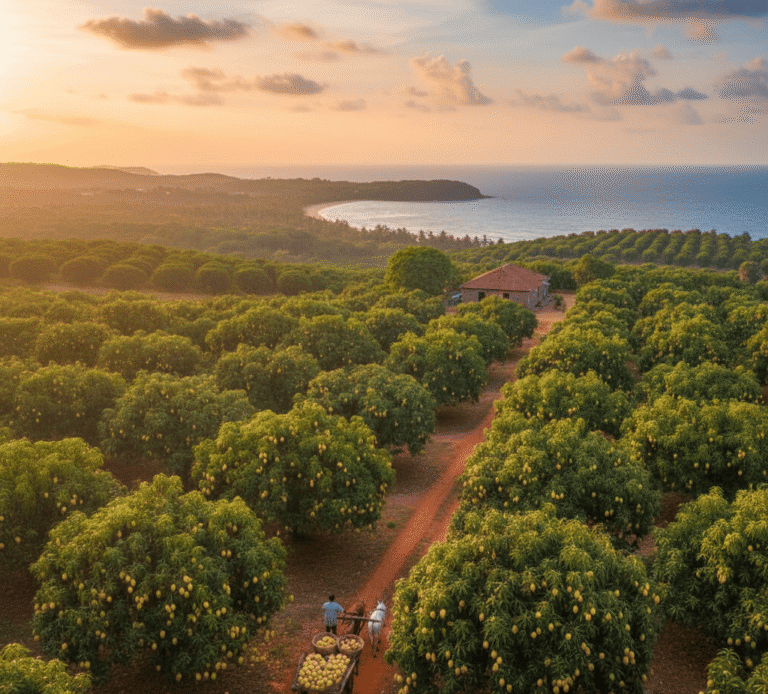The sun-kissed Konkan coast, stretching gracefully from Maharashtra through Goa to Karnataka, harbors one of India’s most fascinating yet underexplored culinary traditions. Here, where seasonal rivers meet the Arabian Sea and monsoon rains nurture fertile lands, a unique gastronomic heritage has flourished for over two millennia. Welcome to the world of Konkani cuisine – where every meal tells a story of cultural confluence, maritime abundance, and time-honored family traditions.
The Humble Khanavals: Where Authentic Flavors Come Alive
Scattered along the Konkan coastline like hidden gems, khanavals represent the heart and soul of authentic Konkani dining. These unassuming “home kitchens” – as the name literally translates – might not win any awards for their exterior aesthetics, but they offer something far more valuable: generations-old recipes prepared with love and served with pride.
Picture this: weathered iron tables draped with faded tablecloths, simple plastic chairs, and a handwritten menu chalked on a blackboard. Children reluctantly abandon their toys to help serve guests, displaying the charming indifference that only authentic family establishments possess. While you won’t find alcohol here, what awaits your palate is nothing short of extraordinary.
These family-run establishments transform their ancestral kitchens into thriving businesses, welcoming weary travelers with dishes that have been perfected over generations. Each khanaval serves as a living museum of Konkani culinary heritage, where traditional recipes are passed down like precious heirlooms.
A Rich Tapestry of History and Cultural Influences
Ancient Roots and Maritime Legacy
The Konkan belt’s culinary story begins with its earliest inhabitants – the Austric tribes including the Kharvis, Mundaris, and Kols. According to ancient Vedic texts, Indo-Aryans migrated to this region around 2400 BCE, followed by Dravidians from the Deccan Plateau between 1700-1400 BCE. This early cultural mixing laid the foundation for the region’s diverse food traditions.
Over two millennia, powerful dynasties including the Satavahanas, Chalukyas, Rashtrakutas, and Shilaharas established strategic ports along the coast. Cities like Sopara (modern-day Thane district) and Chinchani (Palghar district) became bustling trade centers, facilitating exchanges with Greeks, Arabs, and Egyptians – each culture leaving subtle imprints on local cuisine.
The Portuguese Revolution in Konkani Kitchens
The most transformative influence came with Portuguese colonization beginning in 1510. The Portuguese didn’t just establish political control; they revolutionized Konkani cooking by introducing ingredients that are now considered quintessentially local:
- Sweet potatoes and regular potatoes – now staples in countless dishes
- Tomatoes – essential for many gravies and chutneys
- Cashew nuts – featuring prominently in both savory dishes and beverages
- Red chilies – providing the characteristic heat in Konkani cuisine
These foreign ingredients didn’t replace traditional foods but rather blended seamlessly with local cooking techniques, creating the unique flavor profiles that define modern Konkani cuisine.
The Science Behind Konkani Flavors
Vatan: The Foundation of Flavor
At the heart of authentic Konkani cooking lies the vatan – a pre-prepared base mixture that serves as the backbone of most gravies. This ingenious culinary innovation combines browned onions and fresh coconut into a paste that can be refrigerated for weeks, acting as both a time-saver and flavor enhancer.
The preparation technique remains remarkably consistent across the Konkan belt, though family variations add personal touches. Meat is typically marinated and seared to seal in juices before being combined with vatan, creating dishes where every ingredient’s essence is preserved and amplified.
Traditional Techniques vs. Modern Convenience
Historically, Konkani cooking was a meditative, slow process. Earthen vessels allowed for gentle, even cooking that tenderized tough cuts of meat over hours. Stone mortars and pestles released essential oils from spices in ways that modern electric grinders simply cannot replicate.
While pressure cookers and mixers have made cooking more convenient, some traditional khanavals still employ ancient methods, understanding that certain flavors can only be achieved through patience and traditional tools.
The Ocean’s Bounty: Understanding Konkani Seafood
Deep-Water Fish: The Tourist Favorites
Most khanavals today feature pomfret, surmai (seer fish), and bangda (mackerel) – deep-water varieties that weren’t traditionally preferred by locals. Interestingly, the massive influx of tourists from Gujarat and central Maharashtra has driven demand for these Mumbai-sourced fish, sometimes at the expense of truly local varieties.
Local Treasures: The Real Konkani Experience
For the authentic Konkani seafood experience, seek out these local specialties:
Mandeli (Anchovies): These tiny fish are deep-fried to crispy perfection, making exceptional appetizers that pair beautifully with sol kadhi.
Tamoshi (Red Snapper): Traditionally stuffed with aromatic masalas and roasted over coal fires, creating a smoky flavor that epitomizes coastal cooking.
Mori (Shark): With a texture closer to red meat, shark is perfect for robust, thick curries that showcase the bold flavors of Konkani spice blends.
Vam (Conger Eel): Perhaps the most challenging fish to prepare properly, requiring expertise to achieve the perfect balance of delicate stir-frying with subtle spicing.
Tisrya (Clams): Extremely popular throughout the region, usually prepared in light, watery masalas that highlight their natural briny sweetness.
Dried Prawns: These feature in everything from simple khichdi to complex chutneys, with the famous sukat chutney being a regional specialty.
Sol Kadhi: The Perfect Digestive Companion
No discussion of Konkani cuisine is complete without highlighting sol kadhi – the region’s signature drink that doubles as a digestive aid. This beautiful pink beverage combines:
- Kokum (garcinia indica) for its distinctive tart flavor and natural cooling properties
- Fresh coconut milk for richness and neutralizing heat
- Green chilies and garlic paste for subtle warmth and depth
Every family guards their unique proportions of spices, garlic, and salt, creating subtle variations that make each sol kadhi experience unique. Served alongside every thali, it perfectly counterbalances the bold spices in Konkani food while aiding digestion.
Deconstructing the Classic Konkani Thali
A traditional Konkani thali represents perfect nutritional and flavor balance:
The Centerpiece: Fried fish (typically seer fish or pomfret in restaurants) The Curry: A small bowl of prawn or fish curry with rich, coconut-based gravy The Staple: Steamed rice, often locally grown varieties The Digestive: Sol kadhi in a separate glass The Bread: Ghavan (delicate rice flour pancakes) The Extras: Side servings of prawns, clams, or crabs
Regional variations become apparent as you travel from north to south Konkan. Southern preparations use more coconut for thickening gravies and feature tirphal (Sichuan peppercorns) more prominently in spice blends.
Signature Dishes That Define the Region
Kombdi Vade: The Crown Jewel
Kombdi vade represents Konkani cuisine at its most sophisticated – tender chicken slow-cooked in a dark, rich gravy made from caramelized onions and dried coconut, served alongside the region’s famous vadas.
These Konkani vadas differ dramatically from their South Indian namesakes. Resembling puris in appearance, they require a complex preparation process involving five different flours (wheat, rice, gram, and others) mixed in precise proportions. The resulting dough is rolled thin and deep-fried to create crispy, flaky bread that perfectly complements rich gravies.
Kajuchi Bhaji: Cashew Curry Perfection
Kajuchi bhaji showcases how Portuguese-introduced cashews became integral to local cuisine. Dry-roasted cashews are ground into a luxurious gravy using goda masala – a special spice blend that imparts a subtle sweetness without any added sugar or jaggery.
This curry pairs exceptionally well with phansachi bhaji (jackfruit curry), creating combinations that highlight the Konkani genius for balancing flavors and textures.
Community Culinary Traditions
Saraswat Brahmin: Pesco-Vegetarian Philosophy
The Saraswat Brahmin community presents one of India’s most interesting dietary philosophies. While avoiding all land-dwelling animals, they consider fish “vegetables from the sea” – a classification that has produced some of the region’s most spectacular seafood preparations.
Their cuisine tends toward milder spicing compared to other Konkani styles, focusing on subtle flavors that highlight natural ingredients. The Sattvik Brahmin subset follows even stricter guidelines, avoiding potatoes, onions, garlic, and other ingredients, similar to Jain dietary principles.
CKP Community: Masters of Meat
The Chandraseniya Kayastha Prabhu (CKP) community brings a fascinating migration story to Konkani cuisine. Originally from the Kashmir-Sindh region during the Indus Valley Civilization, they migrated to central India in the 7th-8th centuries, finally settling along the Konkan coast in the 12th century when 42 families fled Mandu after Alauddin Khilji’s conquest.
Despite not being Brahmins, they achieved scholarly status, and their unrestricted approach to meat created some of the region’s finest non-vegetarian preparations. Their signature CKP garam masala – featuring tirphal, poppy seeds, and fennel – creates complex flavor profiles that set their meat dishes apart.
Modern Konkani Cuisine: Tradition Meets Innovation
Contemporary Konkani cooks face the challenge of preserving authentic flavors while adapting to modern lifestyles. Many are experimenting with fusion approaches, incorporating global techniques while maintaining traditional taste profiles.
However, the most successful modern Konkani restaurants and khanavals understand that authenticity cannot be rushed. They invest in quality ingredients, maintain traditional spice-grinding methods where possible, and most importantly, respect the time-honored techniques that create the complex layered flavors that make Konkani cuisine unique.
Planning Your Konkani Culinary Adventure
Best Times to Visit
The post-monsoon period (October to February) offers the best experience for exploring Konkani cuisine. Fresh catches are abundant, seasonal vegetables are at their peak, and the pleasant weather makes dining in open-air khanavals particularly enjoyable.
What to Look For
Authentic khanavals can be identified by:
- Family-run operations with multiple generations involved
- Handwritten menus with local fish varieties
- Fresh coconut being grated on-site
- The distinctive aroma of roasting spices
- Sol kadhi served with every meal
Regional Specialties to Seek Out
North Konkan: Milder spicing, more Portuguese influence Central Konkan: Balance of heat and coconut richness South Konkan (Malvani): Bolder spices, prominent use of tirphal
Bringing Konkani Flavors Home
Essential Ingredients to Source
- Kokum: Available dried or in concentrate form
- Tirphal: Often sold as “teppal” in Indian grocery stores
- Goda masala: Can be made at home or purchased from Maharashtrian specialty stores
- Fresh coconut: Essential for authentic flavors
Basic Techniques to Master
Start with learning to make vatan – this single technique will unlock dozens of authentic Konkani dishes. Practice grinding spices by hand when possible, and don’t rush the browning process that develops deep, complex flavors.
Conclusion: A Culinary Heritage Worth Preserving
Konkani cuisine represents far more than just another regional Indian food tradition. It embodies centuries of cultural exchange, maritime abundance, and family wisdom passed down through generations. Every meal in a traditional khanaval connects you to this rich heritage – from the Portuguese traders who introduced tomatoes and chilies to the ancient fishing communities who first learned to transform the ocean’s bounty into culinary art.
As modernization threatens traditional cooking methods and global ingredients compete with local varieties, preserving authentic Konkani cuisine becomes increasingly important. Each visit to a khanaval, each traditionally prepared meal, and each family recipe passed down represents a small but significant act of cultural preservation.
The next time you find yourself along India’s western coast, don’t be deterred by a khanaval’s humble appearance. Step inside, order a traditional thali with sol kadhi, and prepare to discover one of India’s most remarkable culinary treasures. Your taste buds – and your understanding of India’s incredible cultural diversity – will be forever enriched.


